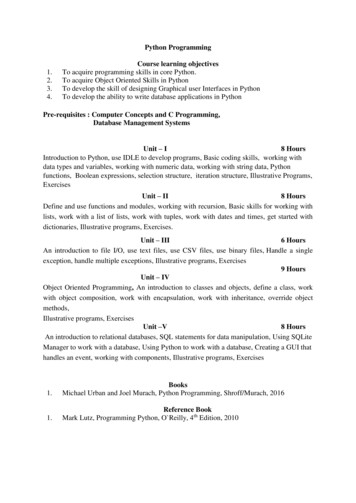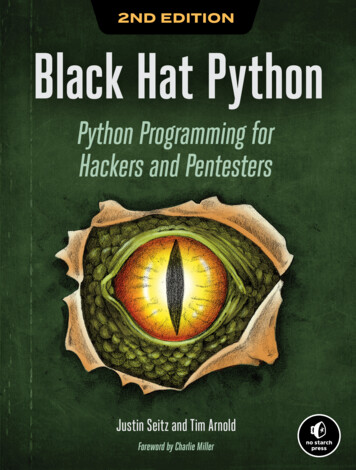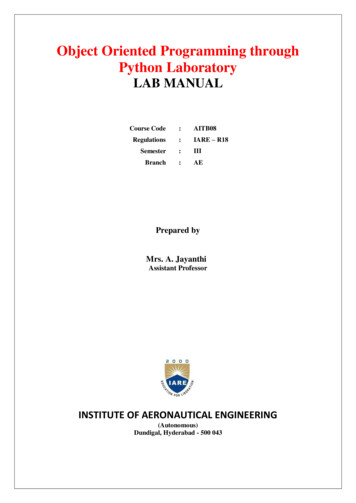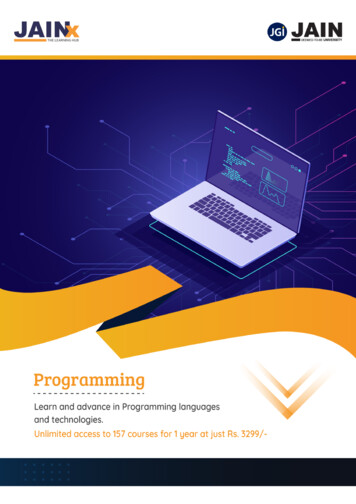
Transcription
RGM COLLEGE OF ENGINEERING & TECHNOLOGY(Autonomous)Approved by AICTE, New Delhi.Accredited by NAAC with A Grade.Affiliated to J.N.T.University, Ananthapuram.Nandyal – 518501. Kurnool (dist.), A.P.YEAR/SEMESTER: II/IREGULATIONS: R-19PYTHON PROGRAMMING (A0503193)COURSE MATERIALPREPARED BY:Mr. P. PRATHAP NAIDUASSISTANT PROFESSORDEPARTMENT OF CSERGMCET (Autonomous)NANDYAL - 518501DEPARTMENT OF COMPUTER SCIENCE & ENGINEERING
CSE-R-2019 SYLLABUSR G M COLLEGE OF ENGINEERING & TECHNOLOGY, NANDYALAUTONOMOUSCOMPUTER SCIENCE ENGINEERINGII B.Tech. I-Sem (CSE)TC2 13PYTHON PROGRAMMING (A0503193)(Common to all Branches)COURSE OBJECTIVES: This course will enable students to: Learn Syntax and Semantics of various Operators used in Python. Understand about Various Input, Output and Control flow statements of Python. Handle Strings and Files in Python. Understand Lists, Tuples in Python. Understand Sets, Dictionaries in Python. Understand Functions, Modules and Regular Expressions in Python.COURSE OUTCOMES: The students should be able to: Examine Python syntax and semantics and be fluent in the use of various Operatorsof Python. Make use of flow control statements and Input / Output functions of Python. Demonstrate proficiency in handling Strings and File Systems. Create, run and manipulate Python Programs using core data structures like Listsand Tuples. Apply the core data structures like Sets and Dictionaries in Python Programming. Demonstrate the use of functions, modules and Regular Expressions in Python.MAPPING OF COs & 111111111111UNIT – I:Introduction: History of Python, Need of Python Programming, Applications Basics ofPython Programming Using the REPL(Shell), Running Python Scripts, Variables,Assignment, Keywords, Input-Output, Indentation. Overview on data types: Numbers,Strings, Lists, Set, Tuple and Dictionaries.Operators in Python: Arithmetic Operators, Comparison (Relational) Operators,Assignment Operators, Logical Operators, Bitwise Operators, Shift Operators, Ternaryoperator, Membership Operators, Identity Operators, Expressions and order of evaluations.Illustrative examples on all the above operators.UNIT – II:Input and Output statements: input() function, reading multiple values from the keyboardin a single line, print() function, ‘sep’ and ‘end’ attributes, Printing formatted string,replacement operator ({}). Illustrative examples on all the above topics.Control flow statements: Conditional statements – if, if-else and if-elif-else statements.Iterative statements – for, while. Transfer statements – break, continue and pass.Illustrative examples on all the above topics.UNIT – III:Strings: Introduction to strings, Defining and Accessing strings, Operations on string String slicing, Mathematical Operators for String, Membership operators on string,Removing spaces from the string, Finding Substrings, Counting substring in the givenString, Replacing a string with another string, Splitting of Strings, Joining of Strings,Changing case of a String, Checking starting and ending part of the string, checking type ofcharacters present in a string. Illustrative examples on all the above topics.Files: Opening files, Text files and lines, Reading files, Searching through a file, Using try,except and open, Writing files, debugging.
CSE-R-2019R G M COLLEGE OF ENGINEERING & TECHNOLOGY, NANDYALAUTONOMOUSCOMPUTER SCIENCE ENGINEERINGUNIT – IV:Lists: Creation of list objects, Accessing and traversing the elements of list. Importantfunctions of list – len(), count(), index(), append(), insert(), extend(), remove(), pop(),reverse() and sort(). Basic Operations on list: Aliasing and Cloning of List objects,Mathematical Operators for list objects, Comparing list objects, Membership operators onlist, Nested Lists, List Comprehensions. Illustrative examples on all the above topics.Tuples: Creation of Tuple objects, Accessing elements of tuple, Mathematical operators fortuple, Important functions of Tuple – len(),count(),index(), sorted(), min(), max(), cmp().TuplePacking and Unpacking. Illustrative examples on all the above topics.UNIT – V:Sets: Creation of set objects, Accessing the elements of set. Important functions of set –add(), update(), copy(), pop(),remove(),discard(),clear(). Basic Operations on set Mathematical Operators for set objects, Membership operators on list, Set Comprehensions.Illustrative examples on all the above topics.Dictionaries: Creation of Dictionary objects, Accessing elements of dictionary, Basicoperations on Dictionary - Updating the Dictionary, Deleting the elements from Dictionary.Important functions of Dictionary – dict(), len(), clear(), get(), pop(), popitem(), keys(),values(), items(), copy(), setdefault(). Illustrative examples on all the above topics.UNIT – VI:Functions - Defining Functions, Calling Functions, Types of Arguments - KeywordArguments, Default Arguments, Variable-length arguments, Anonymous Functions, Fruitfulfunctions (Function Returning Values), Scope of the Variables in a Function - Global andLocal Variables. Recursive functions, Illustrative examples on all the above topics.Modules: Creating modules, import statement, from Import statement.Regular Expressions: Character matching in regular expressions, Extracting data usingregular expressions, Combining searching and extracting, Escape character.TEXT BOOKS1) Python for Everybody: Exploring Data Using Python 3, 2017 Dr. Charles R.SeveranceREFERENCE BOOKS1) Think Python, 2 Edition, 2017 Allen Downey, Green Tea Press2) Core Python Programming, 2016 W.Chun, Pearson.3) Introduction to Python, 2015 Kenneth A. Lambert, Cengages4) https://www.w3schools.com/python/python reference.asp1) https://www.python.org/doc/
UNIT - 1Python Language FundamentalsTopics Covered:IntroductionApplication areas of PythonFeatures of PythonLimitations of PythonFlavours of PythonPython VersionsIdentifiersReserved WordsDatatypesTypecastingNOTE: If you really strong in the basics, then remaining things will become so easyL1: What is Pyhton?It is a Programming Language.- We can develop applications by using this programming language.We can say that, Python is a High-Level Programming Language. Immediately you may get doubt that,What is the meaning of High-Level Programming Language.- High-Level means Programmer friendly Programming Language. This means we are notrequired to worry about Low-levelthings [i.e., Memory management, security, destroying the objects and so on.]- By simply seeing the code programmer can understand the program. He can write the code vey easily.- High level languages are Programmer friendly languages but not machine friendlylanguages.Let's take the following rse/Python Language Fundamentals.ipynb1/81
Let s take the following example,a 10Python Language Fundamentalsb 20c 30 if a b else 40print(c)Do you Know, if we can take this code, are in a position to understand this code?You are not required to have any programming knowledge.By observing the code you can say that, the value stored in C is 40If you have the kid, can you please show this 4 lines code and ask what is the ouput, your kid is able to answerwithout having any hesitation. This type of thing is called as High level programming.Examples of High Level Programming Languages :CC JavaC#PythonYou may get doubt that, you are writing just 4 lines code, is it really a Python code? Is it going to Work?Let's execute and see what happens,In [1]:a 10b 20c 30 if a b else 40print(c)40It is perfectly Python code. This is called High level programming.Python is a General Purpose High Level Programming Language.Here, General Purpose means Python is not specific to a particular area, happily we can use Python for anytype of application areas. For example,Desktop ApplicationsWeb nCourse/Python Language Fundamentals.ipynb2/81
14/04/2020Python Language FundamentalsData Science ApplicationsMachine learning applications and so on.Everywhere you can use Python.L2: Who Developed Pyhton?Who provides food for most of the programmers across the worldwide.Guido Van Rossum developed Python language while working in National Research Institute (NRI) inNetherland.When he developed this Language?Most of the people may think that so far we are heared about Java, C and C and we are recently knowingabout python (especially in our INDIA) and they may assume that Python is a new programming language andJava is a old programming language.Java came in 1995 and officially released in 1996.Python came in 1989, this means that Python is Older programming language tha Java. Even it isdeveloped in 1989, but it is not released to the public immediately.In 1991, Pyhton made available to the public. Officially Python rleased into the market on 21-02-1991 (i.e.,First version).Then, Immediately you may have a doubt that, Why Python suddenly (in 2019) became Popular?Generally Market rquirements are keep on changing from time to time.Current market situation is, every one talks about- I need Simple Language (i.e., Easy to understandable)- I have to write very less (or) concisecode to fulfill my requirement.- In these days, everyone talks about AI, Machine Learning, Deep Learning, Neuralnetworks, Data Science, IOT.For these trending requirements, best suitable programming language is Python.That's why in these days, Python becomes more popular programming language.For example, Suppose you have a diamond. When there is a value for that diamond is, if the marketrequirement is good for that, then automatically this diamond value grows.Date: 10-04-2020 - Day 2L3. Easyness of Python compared to other programming languagesIf you want to learn Python programming, what is the prerequisite knowledge required?The answer for the above Question ython Language Fundamentals.ipynb3/81
14/04/2020Python Language FundamentalsNothing is required, If you are in a position to read English statements, that is enough to learn Pyhtonprogramming.Eg:If you are learning any programming language, the first application which we discuss is Hello Worldapplication.In 'C'1) #include stdio.h 2) void main()3) {4) printf("Hello World");5) }In 'Java'1) public class HelloWorld2) {3) public static void main(String[] args)4) {5) System.out.println("Hello world");6) }7) }In 'PythonIn [1]:print("Hello World");Hello WorldIn [3]:print("Hello World")# ';' is also optionalHello WorldJust to print 'Hello World',C language takes 5 lines of codeJava takes 7 lines of codeBut, Python takes only one line of /Python Language Fundamentals.ipynb4/81
14/04/2020ut, yt o ta es o y o ee o codePython Language FundamentalsWhen compared with any other prgramming language (C, C , C## or Java), the easiest programminglangague is Python.Let us take another example,To print the sum of Two numbersJava1) public class Add2) {3) public static void main(String[] args)4) {5) int a,b;6) a 10;7) b 20;8) System.out.println("The Sum:" (a b));9) }10) }C1) #include stdio.h 2) void main()3) {4) int a,b;5) a 10;6) b 20;7) printf("The Sum:%d",(a b));8) se/Python Language Fundamentals.ipynb5/81
14/04/2020Python Language FundamentalsIn [6]:a 10b 20print("The Sum:",(a b))# 3 line of codeThe Sum: 30Even we can combine first two lines of the above code into a single lineIn [8]:a,b 10,20print("The Sum: ",a b)The Sum:# 2 linesof code30This is the biggest advantage of python programming. We can do many things with very less code.a 10b 20print("The Sum:",(a b))By seeing the above code, you may get one doubt that, In C & Java we declared variables 'a' and 'b' as inttype. But in Python we didn't declare 'a' and 'b' types. You may ask that, in Python we need not to declare thetype of the variables.In Python, type concept is applicable (int,float . types are there in Python), but we are not required to declaretype explicitly.In Python, whenever we are assigning some value to a variable, based on the provided value, automaticallytype will be considered. Such type of programming languages are known as Dynamically TypedProgramming Languages.In [9]:a 10print(type(a))b class 'int' In [11]:a 10.5print(type(a)) class 'float' In [13]:a Trueprint(type(a)) class 'bool' on Language Fundamentals.ipynb6/81
14/04/2020Python Language FundamentalsIn [15]:a "Karthi"print(type(a)) class 'str' In python, same variable can be used with mutiple types of data.In [17]:a 10print(type(a))a 10.5print(type(a))a "Karthi"print(type(a)) class 'int' class 'float' class 'str' Examples of Dynamically Typed Programming Languages:PythonJavaScript etc.,Examples of Statically Typed Programming Languages:CC Java etc.,There is no prerequisite for learning Python programming. So, Python is recommended as firstprogramming language for beginners.Key points1. Python is a general purpose high level programming language.2. Python was developed by Guido Van Rossam in 1989, while working at National Research Institute atNetherlands.3. Officially Python was made available to public in 1991. The official Date of Birth for Python is : Feb20th 1991.4. Python is recommended as first programming language for beginners.5. Python is an Example of Dynamically typed programming languageWhy the name 'Python'Why Guido Van Rossum selected the name se/Python Language Fundamentals.ipynb7/81
14/04/2020yyPython Language FundamentalsIf you are a fan of any hero or heroine or political leader, generally you are trying to use same name foryour passwords or user ids. It's a very common practice.In The same, Guido Van Rossum also very much impressed with one fun show, The Complete MontyPython's Flying Circus, which was broadcasted in BBC from 1969 to 1974. From this show name, heselected the word Python to his programming language.L4. Python as All RounderC -- Procedural/Functional Programming LanguageC , Java -- Object Oriented Programming LanguagesPerl, Shell Script --- Scripting LanguagesC language missing the benefits of Object oriented programming features like, Encapsulation, Inheritanceand Polymorphism etc.,Similarly OOP languages are not make use of the functional programming feactures up to the maximiumextent.Scrpting language: Group of lines one by one will have to execute.Every Programming language having it's own specific behaviour, that specific pradigm benefits only they aregoing to get.What about Python?Is it Functional Programming language?(OR)Is it Object Oriented Programming language?(OR)Is it Scripting Language?While developing Python, Guido Van Rossum borrowed Functional programming features from CObject Oriented Programming features from C (Because, Java was not developed at that time)Scripting language features from Perl,Shell Script.So, Python is considerd as All Rounder. Python can enjoy the benefits of all types of programming languageparadigms.1. Python as Scripting Language:Scripting Language: Scripting language means a grou of lines of code will be there and they will be executedline by line.No functions concept, No classes concept, just a group lines will be executed one by Python Language Fundamentals.ipynb8/81
14/04/2020Python Language FundamentalsIn elanguage2. Python as Functional Programming Language:In [21]:def ogramminglanguagelanguagelanguagelanguage3. Python as Object Oriented Programming Language:In [22]:class Test:def m1(self):print("Python as Object Oriented Programming Language")test Test()test.m1()Python as Object Oriented Programming LanguageNote:Most of the syntax used in Python borrowed from 'C' & 'ABC' Programming Language.L5. Where We Can Use PythonWe can use Python everywhere. The most common important application areas are as follows:1. For developing Desktop nCourse/Python Language Fundamentals.ipynb9/81
14/04/2020p gpppPython Language FundamentalsThe Applications which are running on a single systems (i.e., Stand alone applications)Eg: Simple Calculator application2. For developing Web ApplicationsEg: Gmail Application, Online E-commerce applications, Facebook application, Blog applications etc.,3. For Network ApplicationsEg: Chatting applications, Client-Server applictaions etc.,4. For Games development5. For Data Analysis Applications6. For Machine Learning applications7. For developing Artificial Intelligence, Deep Learning, Neural Network Applications8. For IOT9. For Data ScieneThat's why Python is called as General Purpose Programming Language.Which Software companies are using PythonInternally Google and Youtube use Python codingNASA and Nework Stock Exchange Applications developed by Python.Top Software companies like Google, Microsoft, IBM, Yahoo, Dropbox, Netflix, Instagram using Python.L6. Features of Python1. Simple and easy to learnConsider English Language, how many words are there in english? Crores of words are there in englishlanguage. If you want to be perfect in english, you should aware about all these words.If you consider Java, You should aware of 53 words. That means when compared to English, learning Javais easy.If you consider Python Programming language, You should aware about 33 Words (Reserved Words). Theperson who can understand these 33 words, then he will become expert in Python.So, Python is a simple programming language. When we read Python program, we can feel like readingenglish statements.For example, if you consider ternary operator in Java,x (10 20)?30:40; --- Java urse/Python Language Fundamentals.ipynb10/81
14/04/2020Python Language FundamentalsIf we ask any person, what this line is doing? 99% of Non-programming people are going to fail unless anduntil if they know Java.If I write the same thing in python,x 30 if 10 20 else 40 ---- Python StatementIf Iwe ask any person, what this line is doing? 99% of Non programming people are going to give correctanswer.When compared with other languages, we can write programs with very less number of lines (i.e, ConciseCode) . Hence more readability and simplicity in the python code.Because of the concise code, we can reduce development and cost of the project.Let us take an example,Assume that We have one file (abc.txt) with some data in it. Write a Python program to read the datafrom this file and print it on the console.If you want to write the code for the above problem in C or Java we need to make use of more lines of code.But if you write program in Python, just 1 line is more enough.In [ ]:# Execution pending2. Freeware and Open SourceFreeware and Open source are not same.Freeware:To use Python, How much Licence fee we need to paid?We need not pay single rupee also to make use of Python. It is freeware, any person can use freely, evenfor business sake also.If you consider Java, Java is vendered by Oracle. (Commercial)If you consider C# , C# is vendered by MicroSoft. (Commercial)If you consider Python, who is vendor for Python? There is no vendor for Python, there is one charitableFoundation, Python Software Foundation (PSF) is responsible for maintainane of Python. PSF is Non-Profitoriented Organization.To use Python, you need not pay any money to PSF. If you want to donate voluntarily for this foundation,you can pay.The corresponding Website for PSF is python.org, from where you have to download Python software.But for Java, from it's 11 version onwards it is the paid version. If you want to use for your personal use orbusiness sake, compulsory licence must be required.C# & .Net also requires licence to use.Open se/Python Language Fundamentals.ipynb11/81
14/04/2020Python Language FundamentalsThe Source code of the Python is open to everyone, so that we can we can customize based on ourrequirement. Because of this multiple flovours of Python is possible.Eg:1. Jython is customized version of Python to work with Java Applications.2. Iron Python is customized version of Python to work with C## & .Net Applications.3. Anaconda Python is customized version of Python to work with Bigdata Applications.One main advantage of Python is for every requirement specific version is availble in the market.We can use our specific version of python and fulfill our requirement.3. High Level Programmimg LanguageHigh level programming language means Programmer friendly language.Being a programmer we are not required to concentrate low level activities like memory management andsecurity etc.Any programmer can easily read and understand the code. Let's see the below example,In [3]:a 20b 30print(a b)504. Platform IndependentAssume that one C program is there, We have three machines are there which are working on three platforms(i.e., Windows,Linux, MAC). Now, we want to distribute One C application to the clients who are working ondifferent platforms. Then what we need to do is,For Windows, a seperate C program must be reqired. A C program for Windows system can't run on Linuxmachine or MAC machine.For Linux, a seperate C program must be reqired. A C program for Linux system can't run on Windowsmachine or MAC machine.For MAC, a seperate C program must be reqired. A C program for MAC system can't run on Linux machineor Windows machine.So, Compulsory for every platform you have to write the platform specific application. Now we have threeapplications and three platforms.So, C programming language is platform dependent language.Assume that one Python program is there, We have three machines are there which are working on threeplatforms (i.e., Windows,Linux, MAC). Now, we want to distribute One Python application to the clients who areworking on different platforms. Then what we need to do ython Language Fundamentals.ipynb12/81
14/04/2020Python Language FundamentalsWrite the Python program once and run it on any machine. This is the concept of Platform Independentnature.So, Python programming language is Platform Independent Language.How platform independent nature is implemented in Python?If you want to run Python application on Windows platform, what must be required is Python Virtual Machine(PVM) for Windows is required. If we provide Python application to the PVM for Windows, PVM is responsibleto convert the python program into Windows specific and execute it.In the same way, If you want to run Python application on Linux platform, what must be required is PythonVirtual Machine (PVM) for Linux is required. If We provide Python application to the PVM for Linux, PVM isresponsible to convert the python program into Linux specific and execute it.In the same way, If you want to run Python application on MAC platform, what must be required is PythonVirtual Machine (PVM) for MAC is required. If We provide Python application to the PVM for MAC, PVM isresponsible to convert the python program into MAC specific and execute it.Platform specific conversions are taken care by PVM.Python program is Platform independentPython Virtual Machine is Platform dependent5. PortabilityIn general poratble means movable. In our childhood days, we heard about portable TV (14 inches), whichcan be moved from one place to another place very easily.Another place where we commonly used the term Portablity is mobile number portability.Now Python application Portability means,- Assume that one windows machine is there, in this machine your python application is running without any difficulty. Because of licence issue or security issue you want to move to Linux machine. If you are migrating to Linux machine from Windows is it possible to migrate your python application or not? Yes, because Pythonapplication never talks about underlying platform. Without performing any changesin your Python application, you can migrate your Python application from one platform to another platform. This is called Portability.6. Dynamically TypedIn Python we are not required to declare type for variables. Whenever we are assigning the value, based onvalue, type will be allocated automatically.Hence Python is considered as dynamically typed language.But Java, C etc are Statically Typed Languages because we have to provide type at the beginning only.This dynamic typing nature will provide more flexibility to the Course/Python Language Fundamentals.ipynb13/81
14/04/2020Python Language Fundamentals7. Python is both Procedure oriented and Object orietedPython language supports both Procedure oriented (like C, pascal etc) and object oriented (like C ,Java)features. Hence we can get benefits of both like security and reusability etc.8. InterprettedWe are not required to compile Python code.If you consider C program, we have to compile and execute the code.If you consider Java program, we have to compile and execute the code.If you consider Python program, we have execute the code. We are not required to compile. InternallyInterpretter is responsible for compilation of the Python code.If compilation fails interpreter raised syntax errors. Once compilation success then PVM (Python VirtualMachine) is responsible to execute.9. ExtensibleYou can extend the functionality of Python application with the some other languages applications. what itmeans that Let us assume that some C program is there, some Java program is there, can we use these applications in ourPython program or not?yes, we can use other language programs in Python.What is the need of that?1. Suppose We want to develop a Python application, assume that some xyz functionality is required todevelop the Python application.2. There is some java code is already there for this xyz functionality. It is non python code. Is it possible touse this non-python code in side our python application.Yes, No problem at all.The main advantages of this approach are:1. We can use already existing legacy non-Python code2. We can improve performance of the application10. EmbeddedEmbedded means it is same as extensible in reverse.We can use Python programs in any other language programs. i.e., we can embedd Python PythonCourse/Python Language Fundamentals.ipynb14/81
14/04/2020Python Language Fundamentals11. Extensive LibraryIn Python for every requirement, a readymade library is availbale.Lakhs of libraries are there in Python.No other programming language has this much of librrary support.Python has a rich inbuilt library.Being a programmer we can use this library directly and we are not responsible to implement thefunctionality.Eg: Write a Python program to generate 6 digit OTPIn Python to generate random numbers already a library is availbale. By make use of that library we canwrite the code in easy manner.In [11]:from random import ),randint(0,9),randint(0,9),randint(0,9))5 0 8 8 3 1If dont want space between numbers, include sep '' at the end. sep means seperator, that is assigned withempty.In [10]:from random import ),randint(0,9),randint(0,9),randint(0,9),sep ''836593Suppose, if we want 10 OTPs, then Python code looks like this:In [8]:from random import randintfor i in urse/Python Language Fundamentals.ipynb15/81
14/04/2020Python Language FundamentalsIn [9]:from random import randintfor i in range(10):# another way of using 920345Conclusion:1. These are the 11 key features of Python programming language.2. Among various features of Python discussed above, the following 3 features are specific to Python- Dynamically Typed- Both Procedural Oriented and Object Oriented- Extensive LibraryThese 3 Features are not supported by any other programming languages like C,C and Java etc.,Date: 11-04-2020 - Day 3L7: Limitations and Flavours of PythonLimitaions of Python:Eventhough Python is effective programming language, there are some areas where Python may not work up tothe mark.Now a days, Machine Learning (ML) is the trending word. To develop ML application, Python is the best choice.The reason is Python contains several libraries, using those libraries we can develop ML applicatios very easily.For example, in Python we have the following modules to perform various operations:There is a module called as numpy, which adds mathematical functions to Python.To import and read data set, we have another module in Python called as se/Python Language Fundamentals.ipynb16/81
14/04/2020Python Language FundamentalsTo project the data in the form of Gr
Introduction Application areas of Python Features of Python Limitations of Python Flavours of Python Python Versions Identifiers Reserved Words Datatypes Typecasting NOTE: If you really strong in the basics, then remaining things will become so easy. L1: What is Pyhton? It is a Programming Language.










